Stefan Abi-Karam
HLS-Eval: A Benchmark and Framework for Evaluating LLMs on High-Level Synthesis Design Tasks
Apr 16, 2025Abstract:The rapid scaling of large language model (LLM) training and inference has driven their adoption in semiconductor design across academia and industry. While most prior work evaluates LLMs on hardware description language (HDL) tasks, particularly Verilog, designers are increasingly using high-level synthesis (HLS) to build domain-specific accelerators and complex hardware systems. However, benchmarks and tooling to comprehensively evaluate LLMs for HLS design tasks remain scarce. To address this, we introduce HLS-Eval, the first complete benchmark and evaluation framework for LLM-driven HLS design. HLS-Eval targets two core tasks: (1) generating HLS code from natural language descriptions, and (2) performing HLS-specific code edits to optimize performance and hardware efficiency. The benchmark includes 94 unique designs drawn from standard HLS benchmarks and novel sources. Each case is prepared via a semi-automated flow that produces a natural language description and a paired testbench for C-simulation and synthesis validation, ensuring each task is "LLM-ready." Beyond the benchmark, HLS-Eval offers a modular Python framework for automated, parallel evaluation of both local and hosted LLMs. It includes a parallel evaluation engine, direct HLS tool integration, and abstractions for to support different LLM interaction paradigms, enabling rapid prototyping of new benchmarks, tasks, and LLM methods. We demonstrate HLS-Eval through baseline evaluations of open-source LLMs on Vitis HLS, measuring outputs across four key metrics - parseability, compilability, runnability, and synthesizability - reflecting the iterative HLS design cycle. We also report pass@k metrics, establishing clear baselines and reusable infrastructure for the broader LLM-for-hardware community. All benchmarks, framework code, and results are open-sourced at https://github.com/stefanpie/hls-eval.
HLSFactory: A Framework Empowering High-Level Synthesis Datasets for Machine Learning and Beyond
May 01, 2024Abstract:Machine learning (ML) techniques have been applied to high-level synthesis (HLS) flows for quality-of-result (QoR) prediction and design space exploration (DSE). Nevertheless, the scarcity of accessible high-quality HLS datasets and the complexity of building such datasets present challenges. Existing datasets have limitations in terms of benchmark coverage, design space enumeration, vendor extensibility, or lack of reproducible and extensible software for dataset construction. Many works also lack user-friendly ways to add more designs, limiting wider adoption of such datasets. In response to these challenges, we introduce HLSFactory, a comprehensive framework designed to facilitate the curation and generation of high-quality HLS design datasets. HLSFactory has three main stages: 1) a design space expansion stage to elaborate single HLS designs into large design spaces using various optimization directives across multiple vendor tools, 2) a design synthesis stage to execute HLS and FPGA tool flows concurrently across designs, and 3) a data aggregation stage for extracting standardized data into packaged datasets for ML usage. This tripartite architecture ensures broad design space coverage via design space expansion and supports multiple vendor tools. Users can contribute to each stage with their own HLS designs and synthesis results and extend the framework itself with custom frontends and tool flows. We also include an initial set of built-in designs from common HLS benchmarks curated open-source HLS designs. We showcase the versatility and multi-functionality of our framework through six case studies: I) Design space sampling; II) Fine-grained parallelism backend speedup; III) Targeting Intel's HLS flow; IV) Adding new auxiliary designs; V) Integrating published HLS data; VI) HLS tool version regression benchmarking. Code at https://github.com/sharc-lab/HLSFactory.
INR-Arch: A Dataflow Architecture and Compiler for Arbitrary-Order Gradient Computations in Implicit Neural Representation Processing
Aug 11, 2023



Abstract:An increasing number of researchers are finding use for nth-order gradient computations for a wide variety of applications, including graphics, meta-learning (MAML), scientific computing, and most recently, implicit neural representations (INRs). Recent work shows that the gradient of an INR can be used to edit the data it represents directly without needing to convert it back to a discrete representation. However, given a function represented as a computation graph, traditional architectures face challenges in efficiently computing its nth-order gradient due to the higher demand for computing power and higher complexity in data movement. This makes it a promising target for FPGA acceleration. In this work, we introduce INR-Arch, a framework that transforms the computation graph of an nth-order gradient into a hardware-optimized dataflow architecture. We address this problem in two phases. First, we design a dataflow architecture that uses FIFO streams and an optimized computation kernel library, ensuring high memory efficiency and parallel computation. Second, we propose a compiler that extracts and optimizes computation graphs, automatically configures hardware parameters such as latency and stream depths to optimize throughput, while ensuring deadlock-free operation, and outputs High-Level Synthesis (HLS) code for FPGA implementation. We utilize INR editing as our benchmark, presenting results that demonstrate 1.8-4.8x and 1.5-3.6x speedup compared to CPU and GPU baselines respectively. Furthermore, we obtain 3.1-8.9x and 1.7-4.3x lower memory usage, and 1.7-11.3x and 5.5-32.8x lower energy-delay product. Our framework will be made open-source and available on GitHub.
GNNBuilder: An Automated Framework for Generic Graph Neural Network Accelerator Generation, Simulation, and Optimization
Mar 29, 2023



Abstract:There are plenty of graph neural network (GNN) accelerators being proposed. However, they highly rely on users' hardware expertise and are usually optimized for one specific GNN model, making them challenging for practical use . Therefore, in this work, we propose GNNBuilder, the first automated, generic, end-to-end GNN accelerator generation framework. It features four advantages: (1) GNNBuilder can automatically generate GNN accelerators for a wide range of GNN models arbitrarily defined by users; (2) GNNBuilder takes standard PyTorch programming interface, introducing zero overhead for algorithm developers; (3) GNNBuilder supports end-to-end code generation, simulation, accelerator optimization, and hardware deployment, realizing a push-button fashion for GNN accelerator design; (4) GNNBuilder is equipped with accurate performance models of its generated accelerator, enabling fast and flexible design space exploration (DSE). In the experiments, first, we show that our accelerator performance model has errors within $36\%$ for latency prediction and $18\%$ for BRAM count prediction. Second, we show that our generated accelerators can outperform CPU by $6.33\times$ and GPU by $6.87\times$. This framework is open-source, and the code is available at https://anonymous.4open.science/r/gnn-builder-83B4/.
FlowGNN: A Dataflow Architecture for Universal Graph Neural Network Inference via Multi-Queue Streaming
Apr 27, 2022
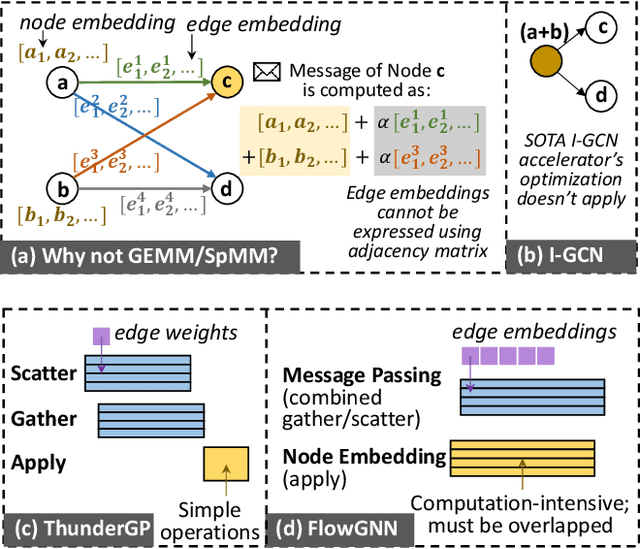
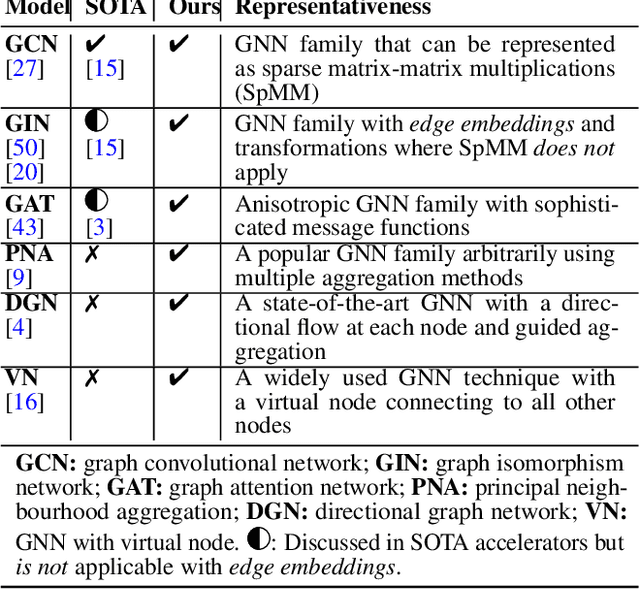
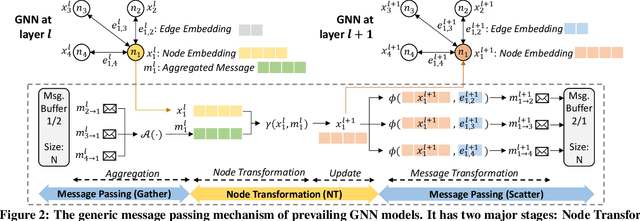
Abstract:Graph neural networks (GNNs) have recently exploded in popularity thanks to their broad applicability to graph-related problems such as quantum chemistry, drug discovery, and high energy physics. However, meeting demand for novel GNN models and fast inference simultaneously is challenging because of the gap between developing efficient accelerators and the rapid creation of new GNN models. Prior art focuses on the acceleration of specific classes of GNNs, such as Graph Convolutional Network (GCN), but lacks the generality to support a wide range of existing or new GNN models. Meanwhile, most work rely on graph pre-processing to exploit data locality, making them unsuitable for real-time applications. To address these limitations, in this work, we propose a generic dataflow architecture for GNN acceleration, named FlowGNN, which can flexibly support the majority of message-passing GNNs. The contributions are three-fold. First, we propose a novel and scalable dataflow architecture, which flexibly supports a wide range of GNN models with message-passing mechanism. The architecture features a configurable dataflow optimized for simultaneous computation of node embedding, edge embedding, and message passing, which is generally applicable to all models. We also propose a rich library of model-specific components. Second, we deliver ultra-fast real-time GNN inference without any graph pre-processing, making it agnostic to dynamically changing graph structures. Third, we verify our architecture on the Xilinx Alveo U50 FPGA board and measure the on-board end-to-end performance. We achieve a speed-up of up to 51-254x against CPU (6226R) and 1.3-477x against GPU (A6000) (with batch sizes 1 through 1024); we also outperform the SOTA GNN accelerator I-GCN by 1.03x and 1.25x across two datasets. Our implementation code and on-board measurement are publicly available on GitHub.
GenGNN: A Generic FPGA Framework for Graph Neural Network Acceleration
Jan 20, 2022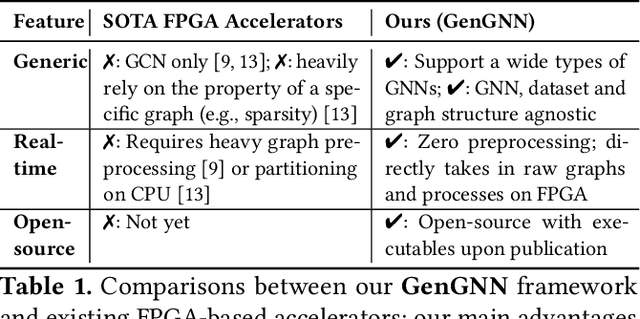
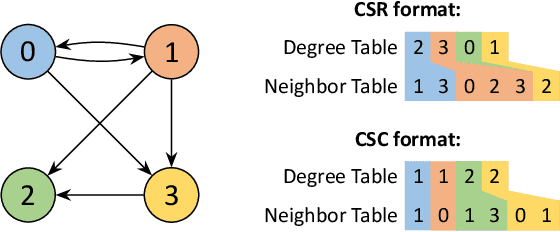
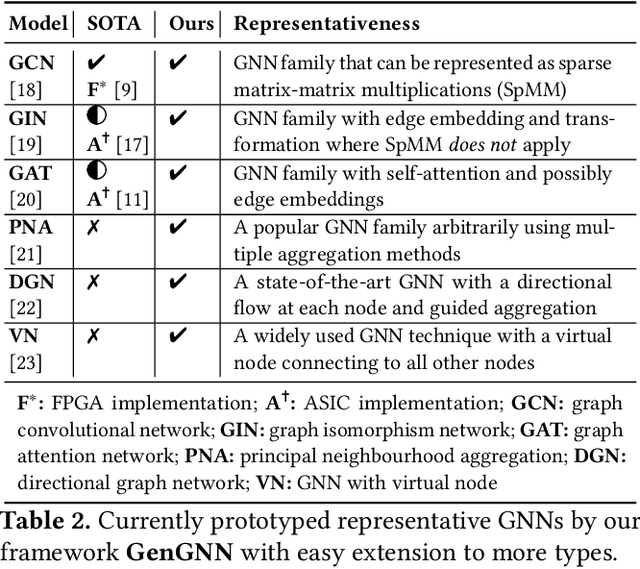
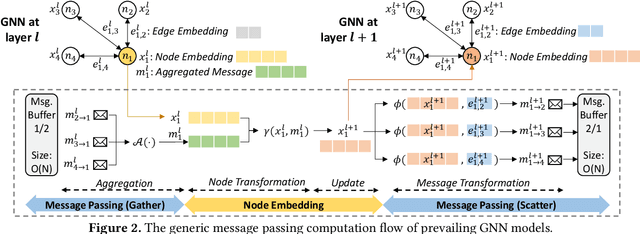
Abstract:Graph neural networks (GNNs) have recently exploded in popularity thanks to their broad applicability to ubiquitous graph-related problems such as quantum chemistry, drug discovery, and high energy physics. However, meeting demand for novel GNN models and fast inference simultaneously is challenging because of the gap between the difficulty in developing efficient FPGA accelerators and the rapid pace of creation of new GNN models. Prior art focuses on the acceleration of specific classes of GNNs but lacks the generality to work across existing models or to extend to new and emerging GNN models. In this work, we propose a generic GNN acceleration framework using High-Level Synthesis (HLS), named GenGNN, with two-fold goals. First, we aim to deliver ultra-fast GNN inference without any graph pre-processing for real-time requirements. Second, we aim to support a diverse set of GNN models with the extensibility to flexibly adapt to new models. The framework features an optimized message-passing structure applicable to all models, combined with a rich library of model-specific components. We verify our implementation on-board on the Xilinx Alveo U50 FPGA and observe a speed-up of up to 25x against CPU (6226R) baseline and 13x against GPU (A6000) baseline. Our HLS code will be open-source on GitHub upon acceptance.
 Add to Chrome
Add to Chrome Add to Firefox
Add to Firefox Add to Edge
Add to Edge